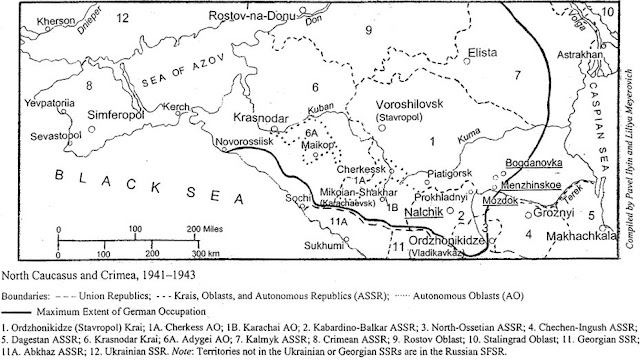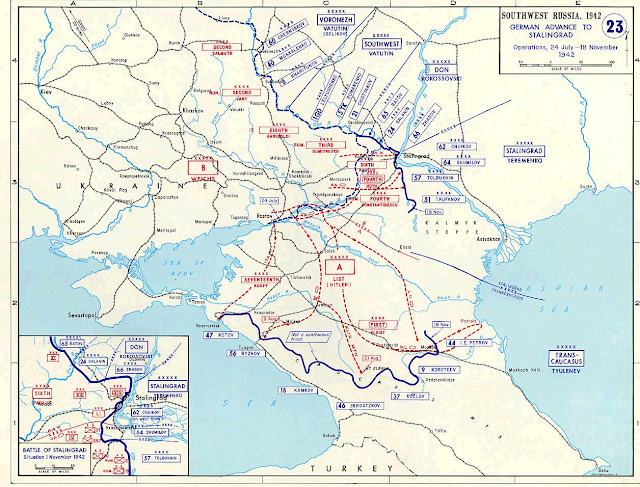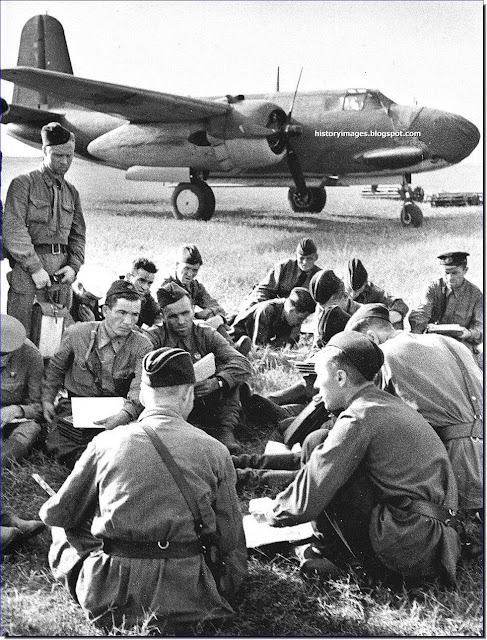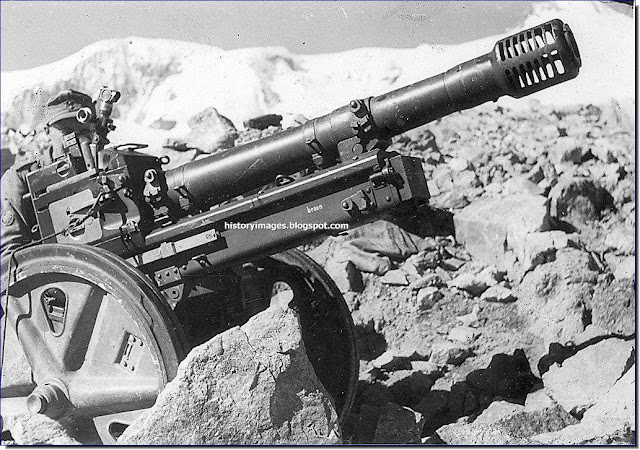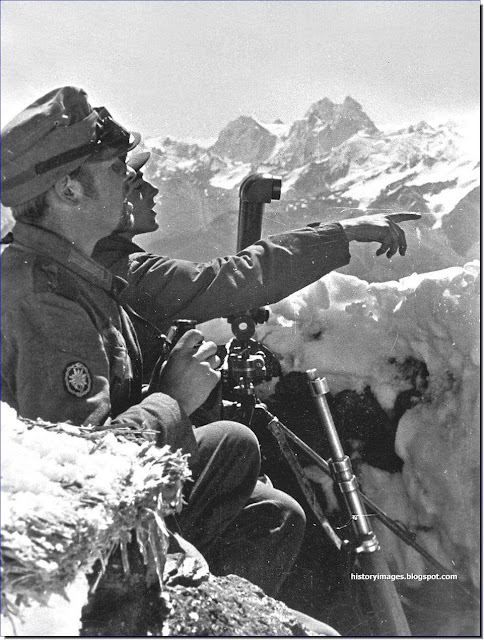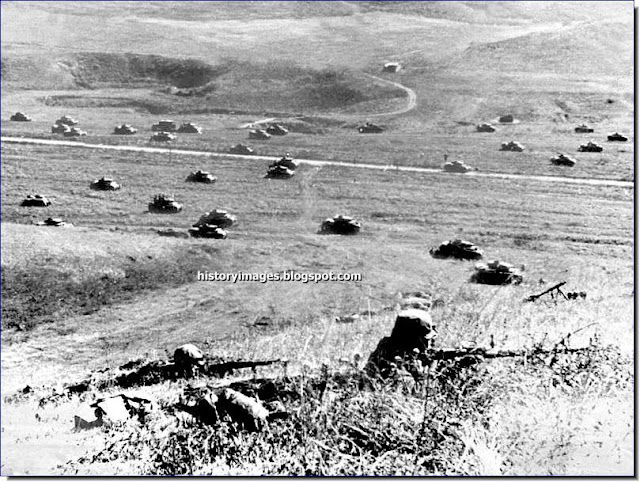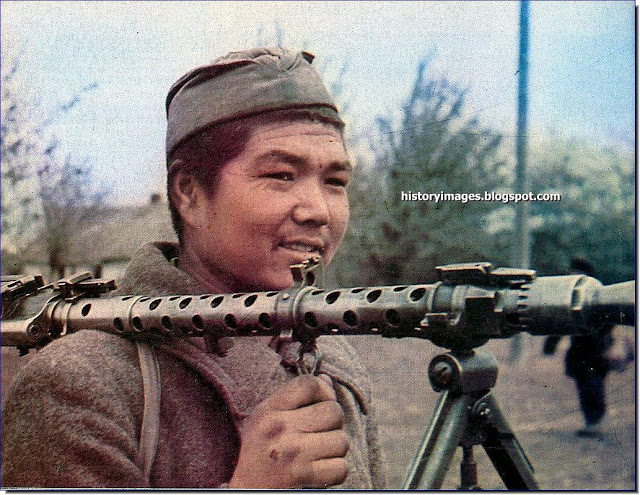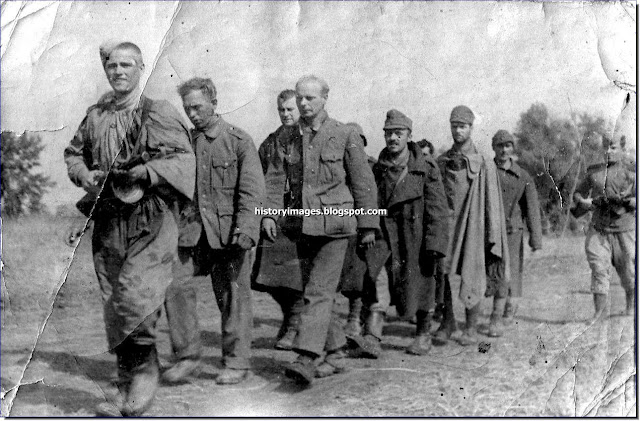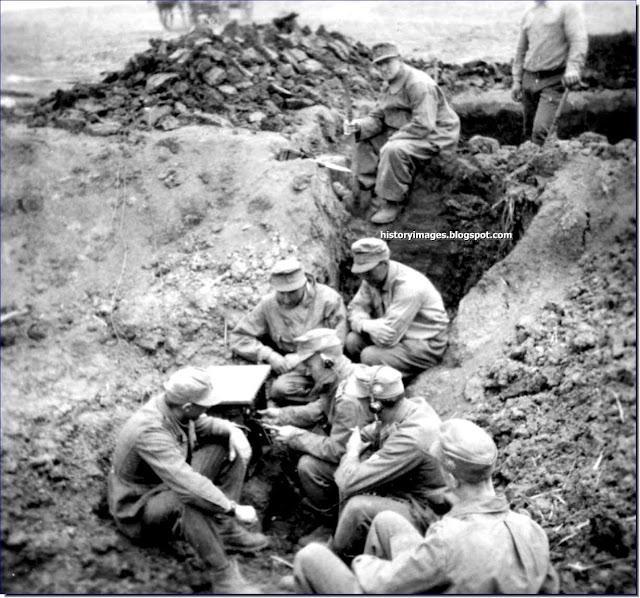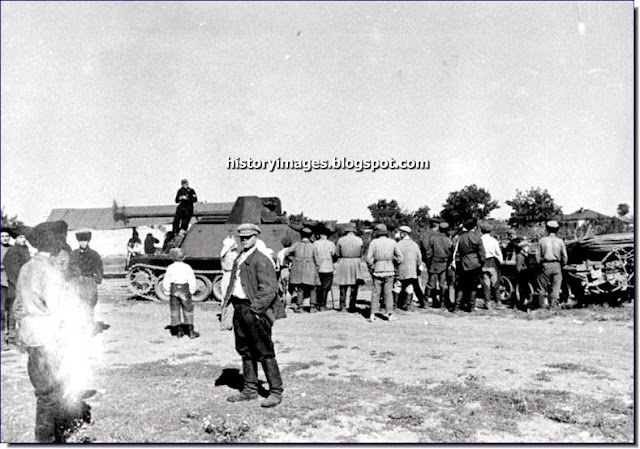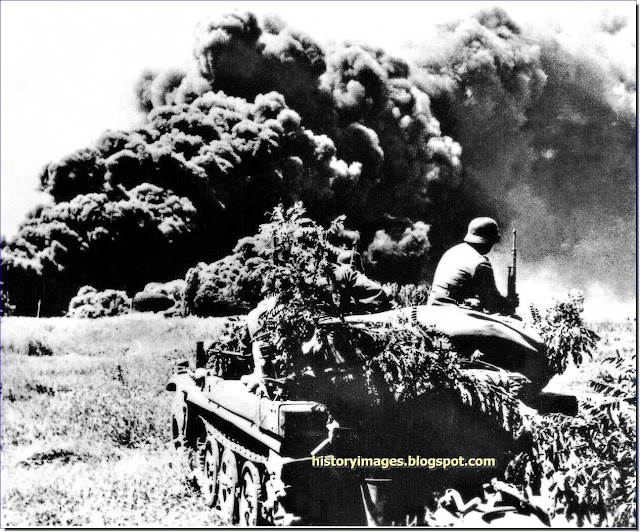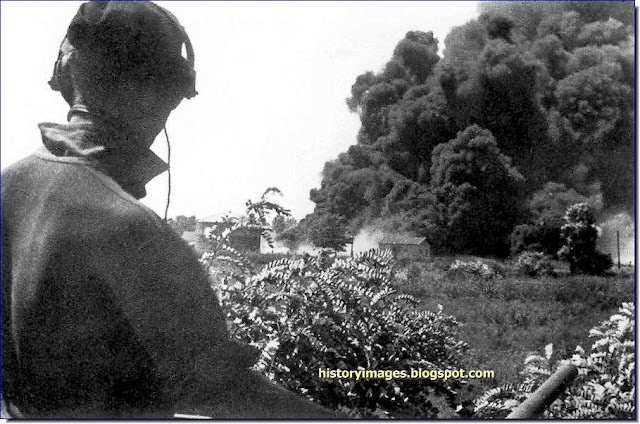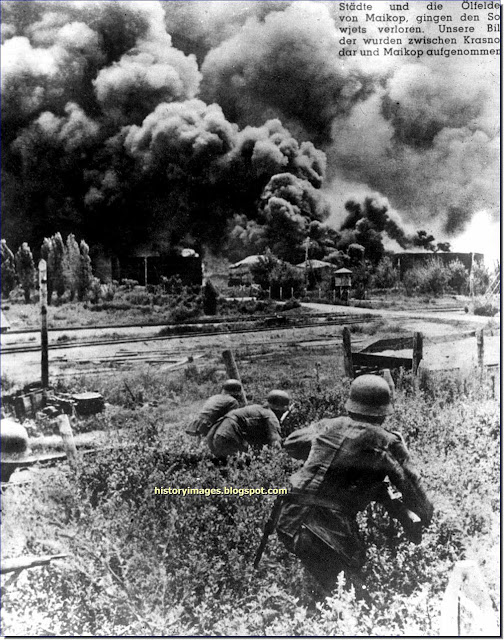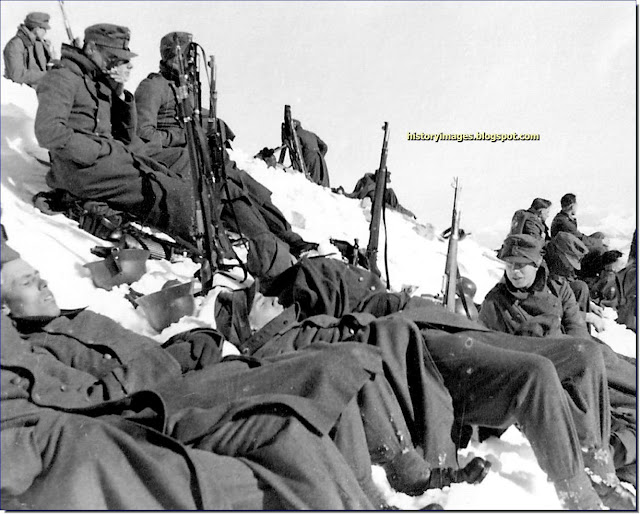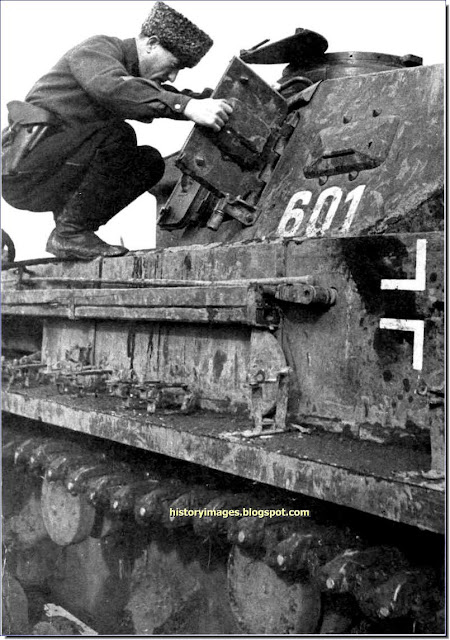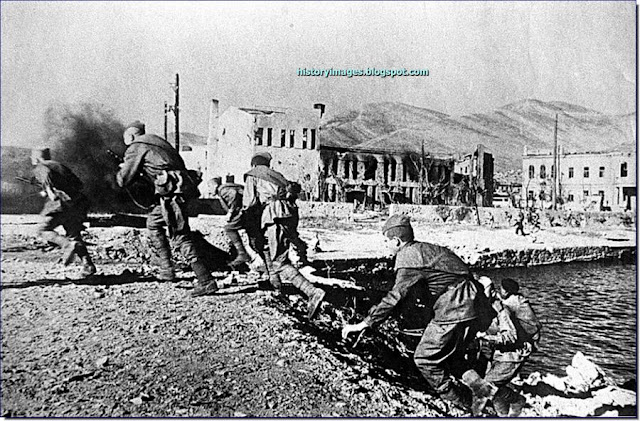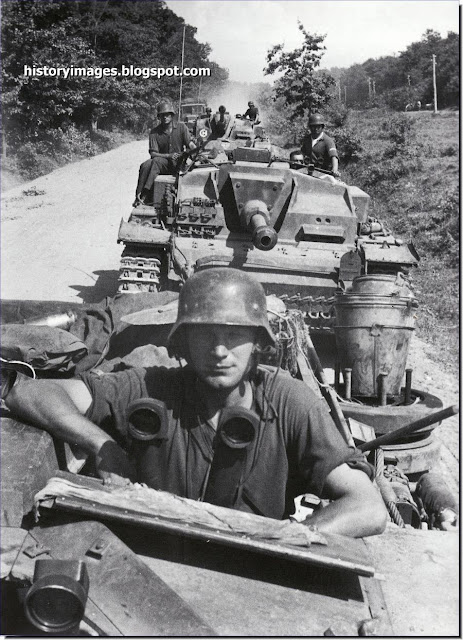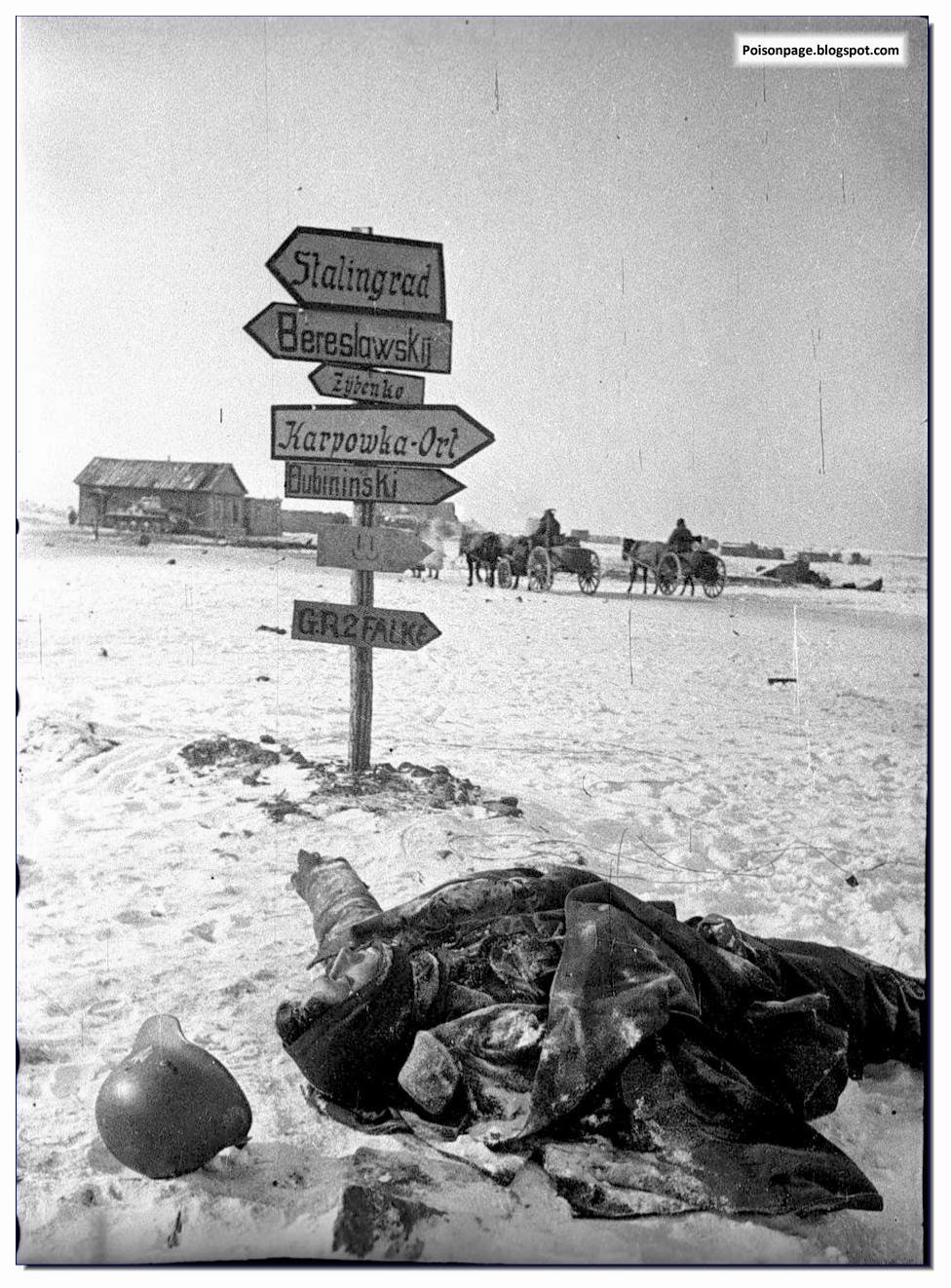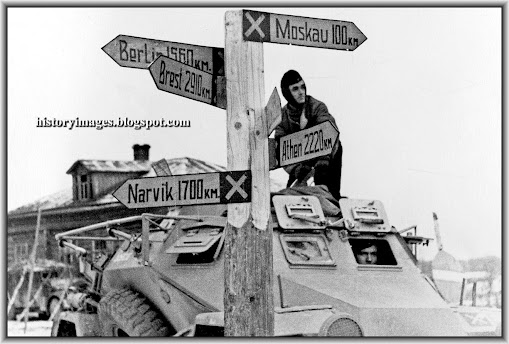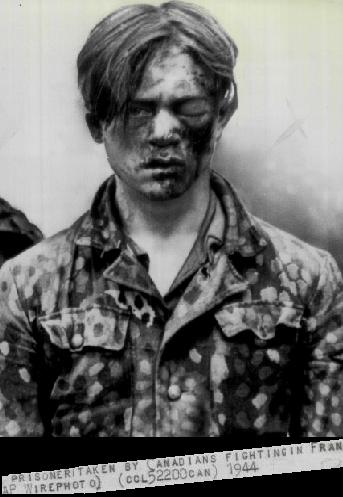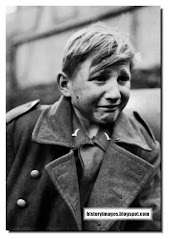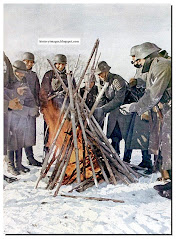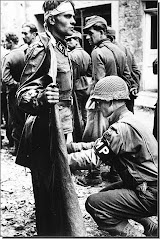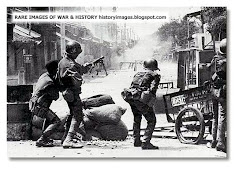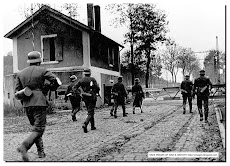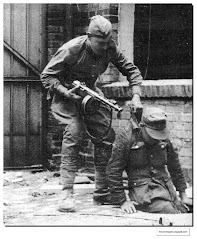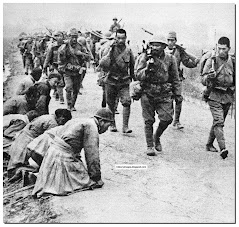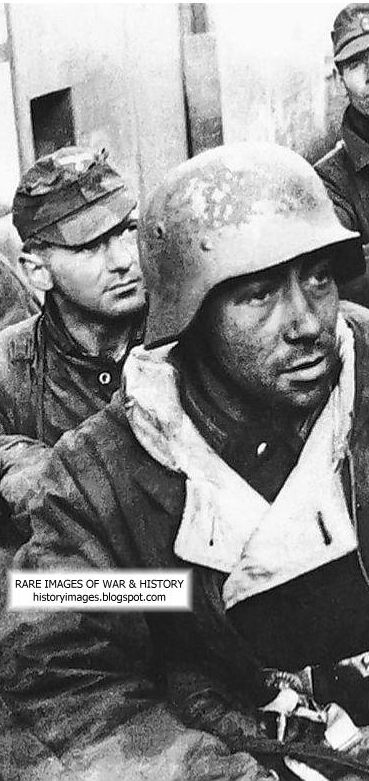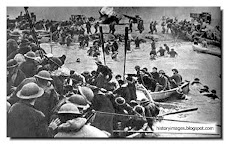German soldiers in a street fight in Novorossiysk. September 1943.
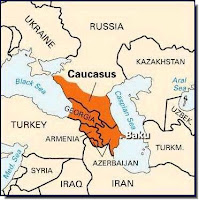
One of the reasons Hitler attacked Russia in 1941 was to get the mineral-rich Caucasus region in the Soviet Union. How far did the German army penetrate into the region? And why couldn't it go further?
April 5th: Hitler orders plans for the execution of Fall Blau (Operation Blue), the new summer offensive on the southern front in the East, designed to reach the Volga, as well as to capture the Caucasus oilfields
Stalingrad. That is the reason why Von Kleist's Ist Panzer Division could not go further onto Baku and occupy the rest of Russia in the Caucasus.
Hitler obsessed with Stalingrad drained away men and supplies from there and poured it into Stalingrad. So the German advance stopped at Nalchik and Mozdok.
In conclusion; it was all about oil after all....
(Click to enlarge image) Image Source: Oxfordjournals
This is as far the Germans got into the Caucasus. Only north Caucasus. It did not even enter south Caucasus. They could never reach or even bomb the oilfields of Baku
-----------------------
“The war was decided by engines and octane.” – Joseph Stalin
“Above all, petrol governed every movement.” – Winston Churchill
German advance to the Caucasus and Stalingrad. July 24, 1942 to November 18, 1942 ( CLICK TO ENLARGE MAP) Source
----------------------------
VIDEO: BATTLE FOR NOVORSSIYSK OCTOBER 1942 (German Newsreel)
-----------------------
“The war was decided by engines and octane.” – Joseph Stalin
“Above all, petrol governed every movement.” – Winston Churchill
German advance to the Caucasus and Stalingrad. July 24, 1942 to November 18, 1942 ( CLICK TO ENLARGE MAP) Source
----------------------------
VIDEO: BATTLE FOR NOVORSSIYSK OCTOBER 1942 (German Newsreel)
OPERATION FALL BLAU
Army Group South was selected for a sprint forward through the southern Russian steppes into the Caucasus to capture the vital Soviet oil fields there. Instead of focusing his attention on the Soviet Capital of Moscow as his general staff advised, Hitler continued to send forces and supplies to the eastern Ukraine. The planned summer offensive was code-named Fall Blau (“Case Blue”). It was to include the German Sixth Army, Seventeenth Army, Fourth Panzer Army and First Panzer Army. Army Group South had overrun the Ukrainian SSR in 1941. Poised in the Eastern Ukraine, it was to spearhead the offensive.
Hitler intervened, however, ordering the Army Group to be split in two. Army Group South (A), under the command of Wilhelm List, was to continue advancing south towards the Caucasus as planned with the Seventeenth Army and First Panzer Army. Army Group South (B), including Friedrich Paulus’s Sixth Army and Hermann Hoth’s Fourth Panzer Army, was to move east towards the Volga and the city of Stalingrad. Army Group B was commanded initially by Field Marshal Fedor von Bock and later by General Maximilian von Weichs.
The Soviet crew of a American Boston A 20 bomber in North Caucasus. October 1942
OPERATION 'FALL BLAU' (CASE BLUE): HITLER'S BLUNDER?
(Historum.com)
OPERATION 'FALL BLAU' (CASE BLUE): HITLER'S BLUNDER?
(Historum.com)
The striking feature of German warfare in World War II was its operational and tactical brilliance in the service of some of the most inept and shortsighted strategic choices in recent military history. The Germans repeatedly won battles and campaigns, but lacked realistic strategies for closing the deal and permanently eliminating their principal enemies.
For instance, the Germans' daring plans and brilliant execution allowed them to quickly overrun France and the Low Countries, but the issue of the final defeat of Britain was not even raised until France surrendered. While the Luftwaffe was pounding Britain in the “softening-up” phase, the Germans produced a completely unrealistic plan for invasion. “Operation Sealion” showed the Germans' complete lack of understanding of amphibious warfare and treated the cross-channel operation as if it was a mere river crossing. The plan had to be based upon a complete neutralization of the British fleet; even so, the Germans' ramshackle fleet of small coastal vessels and barges would have had a tough enough time battling the elements without enemy warships to contend with.
How much of this strategic blundering was due to Adolf Hitler's baleful influence and how much to General Staff shortcomings in this area is an open question, but there were symptoms before World War II of problems with German military thinking. In World War I, the Schlieffen Plan for the conquest of France and Belgium was seriously flawed, with impossible march schedules and logistical demands. And toward the end of the Great War, the German spring offensives of 1918 showed plenty of tactical flare, but little strategic insight.
Nowhere was the Germans' strategic blindness in World War II more evident than on the Eastern Front. The decision to proceed with an invasion of the Soviet Union while Britain still fought on should be seen as a mistake in grand strategy that put Germany in the situation she would have liked to avoid in 1914: a war on two fronts.
Having taken the decision to launch Barbarossa, however, Germany compounded that error by not settling on a single priority objective. The obvious goal was Moscow, but Hitler also wanted to capture or destroy Leningrad and take the Ukraine and the oil-rich Caucasus. If Guderian's panzer group had not been diverted south to close the Kiev pocket, there was a good chance the Germans could have taken Moscow in October. This probably would have probably meant the end of Stalin and the Soviet Union. The Soviet capital in that month was in panic mode, with Soviet forces being routed everywhere and government officials thinking more about escape from the city than in reassuring a stunned populace.
The capture of Moscow at that time would have given all those who had suffered from Stalin's repression a chance to settle old scores. It would also have come at a time when Hitler's intent to annihilate the Russians, not just enslave them, had not yet become clear.
When the Germans finally did near Moscow in late November, the prospect of quick victory had passed. The Soviets had been reinforced with troops from the Far East, and a counteroffensive against the exhausted and half-frozen Germans pushed them back and threatened to destroy Army Group Center.
In planning for 1942, the Germans faced a new problem in grand strategy:
The United States had been added to the list of enemies. Now facing three major powers, the Germans faced the same dilemma they had confronted in 1917, when the U.S. Entered World War I. That is, they had to eliminate or seriously weaken one of their major foes before the Americans geared up to full production and were able to deploy large forces against them.
Clearly, there was no way the Third Reich could come to grips directly with the United States. Their U-Boat campaign against American and British shipping was about the only weapon they had at the moment, and it was not going to do decisive damage. Similarly, Great Britain was almost immune to a knockout blow. An invasion of Britain was no longer possible, and Germany lacked the air power for a devastating bombing campaign. The Mediterranean option, with a campaign in North Africa toward the Suez Canal and a possible invasion of Malta, offered a way to deal Britain severe damage, but it was not going to force a surrender.
Only in the Soviet Union, where the Germans were arrayed against their enemies across hundreds of miles of front, was there a possibility of direct and devastating confrontation. This was the only one of the three major German enemies that could be defeated or at least forced to seek a truce. And although the golden moment in which the capture of Moscow meant victory had passed, that city remained the only logical objective of a major German offensive. The Soviets could be relied on to commit massive forces to defend the Soviet capital, and with Germany retaining a clear superiority in operational skills, the destruction or capture of these forces was still possible in 1942. It would now take a lot more than the capture of Moscow to force the Soviets out of the war; only truly massive Soviet losses in its defense could produce a knockout blow. This outcome was unlikely, but it still posed the only chance the Germans had at this point.
Instead of pursuing this logical objective, Hitler again chose to go after an economic target, this time the oil of the Caucasus, with an operation called Fall Blau (Case Blue). He apparently believed that the seizure of the great Caucasus oilfields would cripple the Soviet war machine. These oilfields did produce as much as 80 percent of the Soviet oil production of nearly 38 million tons in 1941, according to Albert Seaton's “The Russo-German War.” However, he also pointed out that the Soviet Union possessed many other sources of oil, many of them still untapped at the time, and that the Red Army and Air Force consumed only 4.5 million tons of the 1941 oil output.
Of course, possession of the Caucasus would have been a tremendous benefit to the oil-strapped Third Reich. The trick was to hold on to the area long enough for the oil resources to do the Germans any good.
In the process of driving toward the Caucasus, Hitler also aimed to destroy major Soviet forces in the Don River bend and to seize or at least neutralize Stalingrad. The capture of Stalin's namesake city, originally a secondary objective, was to become Hitler's obsession, with fatal results.
Meanwhile, the clearing of the Don bend yielded very disappointing results in Soviet casualties and prisoners. The Soviets had learned the lessons of 1941, and withdrew their main forces in time as the Germans advanced.
In pursuing the objectives of Stalingrad and the Caucasus, Hitler committed a major strategic blunder, splitting Army Group South into Army Groups A and B, and sending Army Group A south into the Caucasus while Army Group B drove on Stalingrad. Thus in an area, where the Germans were operating far from the nearest railhead, they had two major forces operating at right angles to each other and creating enormous supply problems as they drew farther apart.
With all its other shortcomings, the ultimate futility of Fall Blau is shown by the fact that although it achieved nearly complete success in the destruction of Stalingrad and the capture of most of the Caucasus, it left Axis forces in worse shape than they had been at the beginning of the campaign.
By the time of the Soviet counteroffensive that trapped German forces in Stalingrad, the Axis front line had been extended by hundreds of miles. German forces alone could not hold this expanded perimeter, and two Romanian armies held the portions of the line north and south of Stalingrad, while an Italian and a Hungarian army were deployed farther west. Some of the best German forces, Sixth Army and elements of Fourth Panzer Army, were tied down (and ground down) in pointless attritional battles to capture the last bits of Stalingrad. Meanwhile, far to the south, German forces in the Caucasus struggled at the end of long supply lines. After the Soviet counteroffensive, Soviet forces stood much closer to Rostov than Army Group A, threatening to cut off the entire army group.
In looking at German strategic blunders of World War II, Fall Blau stands out as one of the worst. At a time when Germany desperately needed to knock out one of the Allied powers, Fall Blau diverted German forces from the only area where such a decisive blow was possible. It also greatly extended the Axis defenses in the South, making a Soviet counterstroke virtually inevitable. Stalingrad marked the beginning of the end for the Germans in the east. After their failure at Kursk in July 1943, the Axis forces were in retreat until the capture of Berlin.
German 75-mm cannon Geb.G.36 mountain in the Caucasus.
HOW FAR DID THE GERMANS GO IN THE CAUCASUS?
WW2F
HOW FAR DID THE GERMANS GO IN THE CAUCASUS?
WW2F
On August 20, 1942 "Heeresgruppe A" of Von Kleist was ordered to advance to the west to the Black Sea coasts, to capture Krasnodar the capital of Kuban and Maykop, the third largest petrol center in the Caucasus. For inner west, the Wehrmacht if running over route in the direction of Grozny and Baku the other important petrol centers. More petrol installations and industrial centers were falling into German hands intact or lightly damaged during the Russian disorder retreat from the area. In the same month German forces captured the Taman Peninsula and partially the Novorossisk naval base, and continued their advance to Tuapse, the real key for domination of the Soviet Black Sea coast.
In other German efforts units attempted to advance to Grozny and Tbilisi to establish another route, then met the Russians in Mozdok in the south.
In 1942, when Axis forces invaded the Volga Basin area, Hitler rejoiced with the idea of seizing the Kazakh Soviet Socialist Republic, a considerable prize. If stay at 100 miles (200 km) at East with railway nets which offered the Nazis excellent ways to flank the Allied positions in Syria and Iraq and run to British India to establish contact with Japanese.
On November 2, 1942, they captured Nalchik, capital of Kabardo-Balkiar, for pressured to Vladikavkaz (Orjonikidze), capital of Ossetia north of the Georgian military pass. en route to Grozny in the south west area. Later the Germans decided to remain defensive in their posts at Mozdok and Nalchik waiting for the spring of 1943 to retake the offensive if the Stalingrad operations were successful.
The German units in Elista sent a light armored group on a recon mission to nearby Astrakhan, also Sandovska and Senseli in Kazakhstan. Similarly another unit attempted a recon mission from the Vladikavkaz-Grozny sector to Azerbaijan territory; another success was a Wehrmacht high mountain section from the Karachai-Cherkess area, raising Mount Elbrus in the Caucasus Ranges. Some accounts mention a German visit to Mount Kazbek in North Ossetia.
German mountain rangers in the mountains of the Caucasus. In 1942.
POINT TO PONDER: CASE BLUE
POINT TO PONDER: CASE BLUE
In 1942 the Germans executed their Case Blue plan for overunning the Caucasus and seizing control the Caucasian oilfields from the Soviet Union. The view of the role of Stalingrad I got was that it was originally not an objective but became one through Hitler's altering the battle plan in mid course. Yet some say that control of Stalingrad was necessary to enable the Germans to get supplies to their advancing columns as the columns raced towards the Caucasus as Stalingrad was a railway network hub. 1. Could the Germans have simply left a screening force in front of Stalingrad instead of capturing it, concentrated their forces on the Caucasus and then have succeeded in capturing the oil fields? 2. Had the Germans gained control of the oil fields of the Caucasus could the Soviets still have stayed in the war?
German tanks in the foothills of the Caucasus from Mozdok. In 1942
GERMANY'S QUEST FOR OIL: HENCE THE BATTLE IN THE CAUCASUS
From http://forum.axishistory.com/
GERMANY'S QUEST FOR OIL: HENCE THE BATTLE IN THE CAUCASUS
From http://forum.axishistory.com/
At the outbreak of the war, Germany’s stockpiles of fuel consisted of a total of 15 million barrels. The campaigns in Norway, Holland, Belgium, and France added another 5 million barrels in booty, and imports from the Soviet Union accounted for 4 million barrels in 1940 and 1.6 million barrels in the first half of 1941. Yet a High Command study in May of 1941 noted that with monthly military requirements for 7.25 million barrels and imports and home production of only 5.35 million barrels, German stocks would be exhausted by August 1941. The 26 percent shortfall could only be made up with petroleum from Russia. The need to provide the lacking 1.9 million barrels per month and the urgency to gain possession of the Russian oil fields in the Caucasus mountains, together with Ukrainian grain and Donets coal, were thus prime elements in the German decision to invade the Soviet Union in June 1941.
The smallest of the Russian oil fields at Maikop was captured in August 1942, and it was expected that the two remaining fields and refineries in Grozny and Baku also would fall into German hands. Had the German forces been able to capture these fields and hold them, Germany’s petroleum worries would have been over. Prior to the Russian campaign, Maikop produced 19 million barrels annually, Grozny 32 million barrels, and Baku 170 million barrels.
Grozny and Baku, however, were never captured, and only Maikop yielded to German exploitation.
As was the case in all areas of Russian production, the retreating forces had done a thorough job of destroying or dismantling the usable installations; consequently, the Germans had to start from scratch. In view of past experience with this type of Russian policy, such destruction was expected, and Field Marshal Hermann Göring’s staff had begun making the necessary preparations in advance. But a shortage of transport that was competing with military requirements, a shortage of drill equipment as well as drillers, and the absence of refining capacity at Maikop created such difficulties that when the German forces were compelled to withdraw from Maikop in January 1943 in order to avoid being cut off after the fall of Stalingrad, Germany had failed to obtain a single drop of Caucasian oil. Nevertheless, the Germans were able to extract about 4.7 million barrels from the Soviet Union, a quantity that they would have received anyway under the provisions of the friendship treaty of 1939.
Portrait of a voluntary helper Wehrmacht - Hiwi (Hilfswilliger). He carries a machine gun MG-34. The Caucasus, 1942.
-----------------------
INTERESTING SIDELIGHTS: WHO WERE HILFSWILLIGERS (HIWIS)?
------------------------------
-----------------------
INTERESTING SIDELIGHTS: WHO WERE HILFSWILLIGERS (HIWIS)?
The word entered into several languages during World War II when German troops enlisted volunteers from the occupied territories for supplementary service (drivers, cooks, hospital attendants, ammunition carriers, messengers, sappers, etc.).
This term from World War II times is often associated with collaborationism, and, in the case of the occupied Soviet territories, with anti-Bolshevism (and widely presented by Germans as such). Russians in the German Army can be put into three groups:
- First: Soldiers mobilized by German troops, so-called Cossack sections, attached to German divisions.
- Second: Voluntary Assistants (Hilfswillige) - Local civilians or Russian prisoners who volunteer or Red Army soldiers who desert to join the Germans. These wear full German uniform with their own ranks and badges. They eat like German soldiers and they are attached to German regiments.
- Third: Russian prisoners doing the dirty jobs, kitchens, stables and so on. The categories are treated differently, volunteers treated best."
Hiwis were referred to as "former Russians" by the Soviet authorities, regardless of the circumstances of them joining, and their fate at the hands of the NKVD was most likely death or the Gulag.
The reliance upon "Hiwis" exposed a gap between Nazi ideologues and pragmatic German Army commanders. Nazi leaders, such as German dictator Adolf Hitler, regarded all Russians as "sub-human" (Untermensch) and therefore of no value to the "Aryan" German Army. On the other hand, the manpower was needed and German Intelligence had recognised the need to divide the Soviet people. The contradiction was sometimes disguised by their reclassification as Cossacks. Colonel Groscurth (Chief of Staff, XI Corps) wrote to General Beck: "It is disturbing that we are forced to strengthen our fighting troops with Russian prisoners of war, who are already being turned into gunners. It's an odd state of affairs that the "Beasts" we have been fighting against are now living with us in closest harmony." One quarter of 6th Army's front-line strength were Hiwis
------------------------------
Soviet infantry in battle of a Crimean village, April-May 1943.
A group of German POW in the Caucasus. 1943
GERMAN DREAMS IN THE CAUCASUS
German signalmen tune the radio, Kuban, in April 1943.
German soldiers on armored Sd.Kfz.251 watch smoke billowing from burning oil wells of Maikop which were set on fire by retreating Russian forces in the last week of August 1942.
CAUCASIAN OIL AND STALINGRAD
German soldiers approaching a burning oil storage tanks in the area of Maikop and Krasnodar. October 1942
By the early fall, Maikop was in German hands, and by December oil was once again flowing from it, despite vigorous efforts by Soviet partisans and saboteurs. But Army Group A never reached Grozny or Baku. Hitler lost sight of his material goal and instead fastened on one of only symbolic importance – Stalingrad. He transferred eight divisions from Army Group A to B, and with its drive thus weakened, A was unable to break into the mountains. Neither could it resist the Soviet counterattack when it came, and Maikop had to be given up on 18 January 1943.
A campaign that was supposed to have lasted only weeks had stretched into months, then years. Fully half of Germany’s oil reserves were poured into the eastern front. At the start of the 1942 drive, Hitler said, “If I do not get the oil of Maikop and Grozny, then I must end the war.” He should have taken his own advice.
German mountain troops take a break
German soldiers from the Mountain Division in the Caucasus
The Soviet officer inspects a captured tank Pz.Kpfw. IV (Panzer 4). Spring 1943
Part of the Soviet 18th Army on the waterfront of Novorossiysk, 1943.
A column of German StuG III assault guns on the march to the Caucasus.
Russian soldiers move in as the Germans withdraw from the Nalchik area. January 1943
------------------------------------------------------------------------
RECOMMENDED BOOKS
The Caucasus and the Oil, The German-Soviet War in the Caucasus 1942/43
WILHELM TIEKE
The failure to capture the oilfields was a major blunder by Hitler. His obsession with Stalingrad cost him the oil. The Germans was not capable of driving both towards Caucasus and capturing a city built manly in stone. The initial case blue plan did not include the meaningless attack on Stalingrad.
A group of German POW in the Caucasus. 1943
GERMAN DREAMS IN THE CAUCASUS
.....factor which led the Germans to look to the southern segment of the front was the prospect of very significant material and strategic objectives within their reach. The seizure of the oil resources of
the Caucasus would have a triple impact on the war.
It would relieve the shortage of petroleum products which was hampering the German armored forces, hindering the German navy, and immobilizing the Italian navy even as it made Germany dangerously vulnerable to the effects of any air attacks on her synthetic oil works and the Romanian oil wells.
Secondly, the converse of this was, of course, that of depriving the Soviet Union of a very high proportion of its oil resources. Even if her allies could replace some of this, it would necessarily be at the expense of other weapons and supplies they could have sent instead.
Finally, a German force in the Caucasus would be poised for an operation the following year into Iraq and Iran from the north, collapsing the Allied position in the Middle East, turning that region's oil resources from Allied control to the Axis, offering a real opportunity for a meeting with the Japanese and in any case severing the southern supply route of the Western Allies to the Soviet Union.
The fact that along the road to such splendid prospects the Germans would seize those portions of the important industrial region of the Donets basin still under Soviet control, as well as the rich agricultural region of the north Caucasus, only made this whole direction more inviting, even mouth-watering.
It would relieve the shortage of petroleum products which was hampering the German armored forces, hindering the German navy, and immobilizing the Italian navy even as it made Germany dangerously vulnerable to the effects of any air attacks on her synthetic oil works and the Romanian oil wells.
Secondly, the converse of this was, of course, that of depriving the Soviet Union of a very high proportion of its oil resources. Even if her allies could replace some of this, it would necessarily be at the expense of other weapons and supplies they could have sent instead.
Finally, a German force in the Caucasus would be poised for an operation the following year into Iraq and Iran from the north, collapsing the Allied position in the Middle East, turning that region's oil resources from Allied control to the Axis, offering a real opportunity for a meeting with the Japanese and in any case severing the southern supply route of the Western Allies to the Soviet Union.
The fact that along the road to such splendid prospects the Germans would seize those portions of the important industrial region of the Donets basin still under Soviet control, as well as the rich agricultural region of the north Caucasus, only made this whole direction more inviting, even mouth-watering.
German signalmen tune the radio, Kuban, in April 1943.
At first it certainly looked as if all were going swiftly in favor of the
Germans and disastrously for the Soviet Union and its allies. By the
end of July the three armies headed south and southeast were across
the lower 150 miles of the Don and at two places had cut the railway
connecting the North Caucasus area with Stalingrad. In the first two
weeks of August, German troops, moving through some of the richest
agricultural area of the Soviet Union, seized the city of Krasnodar, and
occupied the first of the oil field areas—that near Maikop—which were
a major goal of the whole 1942 operation. The installations had been
wrecked by the Russians, but the Germans expected to fix them while
their forces rushed on to the other oil fields, those at Grozny, 200 miles
further east and those at Baku, an additional 300 miles away. But they
would never reach either of these objectives.
As the Germans raced across the plains of the North Caucasus area
and into the foothills of the mountains themselves, they were able to
make dramatic advances because the Red Army was still retreating; but
in this process the balance began to shift. On the German side, not only
were there supply difficulties as the units covered great distances from
their bases in the Ukraine, but the spearheads became smaller even as
they were increasingly separated by vast distances. By late August,
German forces trying to push their way into the Soviet naval base of
Novorossysk were 300 miles away from those which had captured
Mozdok on the road to Grozny; between those spearheads, others were
trying to force the Caucasus passes to seize Tuapse and Sukhumi on
the Black Sea. At each of these points steadily smaller and more
exhausted German assault units faced the stiffening resistance of a Red
Army summoned to desperate exertions by its government.
The legendary German Field Marshal Erwin Rommel once wrote: “The battle is fought and decided by the quartermasters before the shooting begins.”.
Students of military history tend to pay lip service to the importance of logistics, preferring to read about tanks and artillery, mass and maneuver, attack and counterattack. The reasons for that bias are easy to understand. There is no obvious drama in examining supply lines, and it is easier and simpler to believe wars are always won on battlefields.
An examination of the belligerents’ attempts to secure oil for their countries during World War II, in both the European and Pacific theaters, not only explains many otherwise mysterious events, it also contains
important lessons about potential future conflicts.
German soldiers on armored Sd.Kfz.251 watch smoke billowing from burning oil wells of Maikop which were set on fire by retreating Russian forces in the last week of August 1942.
CAUCASIAN OIL AND STALINGRAD
Operation Blue was the codename for the attack ordered by Adolf Hitler on the Soviet Union’s oil fields in the Caucasus region in 1942. Operation Blue was to fail when the Sixth Army was effectively destroyed at theBattle of Stalingrad. Operation Barbarossa had failed in that the Soviet Union had not surrendered and Moscow had not been captured. However, the success of Barbarossa was such that vast regions of the Soviet Union were in the hands of the Nazis – Byelorussia and the Ukraine were major centres of industry while Kiev and Kharkov were the third and fourth largest cities in the USSR respectively. Estonia, Latvia and Lithuania were all captured and the German war machine held a line that measured nearly 1000 miles from the north near Lake Ladoga to the Sea of Azov in the south. Hitler now ordered that his war machine needed the oil fields in the southwest of the USSR and that the campaign would start after the Russian winter had ended in 1942.
For once Hitler and his senior Wehrmacht strategists agreed on an initial plan. Operation Blue must involve just a single point of attack for maximum effect, a so-called Schwerpunkt. All agreed that the size of the front meant that there could be no overall offensive along the whole line. But almost immediately after this agreement, there were differences expressed. Senior army generals wanted the target for Operation Blue to be Moscow once again. Hitler disagreed and told his generals that the attack would be on the oil fields. He ordered this for two reasons. If the Red Army was starved of fuel it would collapse. If the German military had access to the same oil, it would prosper. Therefore, Hitler ordered that Army Group South would be the beneficiary of whatever was required in terms of military hardware for its attack on Grozny in the Caucasus and Maikop by the Black Sea. Hitler argued that he was right with regards to the attack on Western Europe in the spring of 1940 when his generals had doubted whether it would be a success. He blamed the failure of Barbarossa on the army’s lack of resolve and fighting spirit. Now with Operation Blue they could prove their worth, Hitler argued. He told the Wehrmacht’s High Command, “Either I get the oil of Maikop and Grozny, or I must put an end to this war.”
Operation Blue began on June 22nd 1942, exactly a year to the day of the start of Operation Barbarossa. However, it was very nearly delayed when an army major was shot down while flying over and surveying the Russian lines. He had taken a briefcase with him containing the plans for Operation Blue for that sector and it fell into the hands of Russian troops. The briefcase was immediately sent to Moscow and its contents studied. Stalin decided that its contents were a deliberate ploy to fool the commanders of the Red Army that the attack was going to be in the south when actually it was going to be against Moscow. Therefore he refused to order the movement of troops away from Moscow to the south. No one in the Red Army’s hierarchy was willing to argue with Stalin.
The generals in the Wehrmacht thought about delaying the attack but it went ahead. As with Barbarossa, it was very successful to start with. In early July, Hitler told General Halder, “The Russian is finished.” The very success of Operation Blue was to be its undoing and arguably was to change the course of World War Two in Europe. Hitler believed that because the Red Army in the south was crumbling against the mechanised onslaught of the Wehrmacht’s attack, too many German troops were actually involved and fewer were needed. He concluded that men could be withdrawn to other sectors while still allowing the attack to succeed. He ordered that Army Group South should be divided in two. Group A was to push for the oilfields of the Caucasus and Maikop before moving on to Baku. Group B was to engage the Russians in the region west of the River Don. Therefore the force that was to attack the oilfields was halved in terms of its strength. Also the two-army groups were to act independently as opposed to supporting one another. The Sixth Army under Paulus, the largest formation in Group B, was stripped of the support of the 4th Panzer as this group was ordered to support Group A. However, Hitler later reversed this decision such was the chaos that his leadership could cause. He had divided in two Army Group South, moved a Panzer formation away and then ordered its return to Group B. However, as commander-in-chief of the military, his orders had to be obeyed especially as all members of the military had sworn an oath of loyalty to Hitler.
Why did Hitler do this? It is said that while studying a map of the south of Russia he saw the city of Stalingrad on it. Up to this point, Stalingrad had played little part in any plan of attack. The city would have become involved at some time in the war but it was not initially seen as a major target.
General von Kleist commanded the First Panzer Army. After the war he said:
“The capture of Stalingrad was subsidiary to the main aim. At the start (of the attack) Stalingrad was no more than a name on the map to us.”
Hitler realised that the city had been named after the man who represented all that Hitler despised – an East European Communist. Stalin also governed a country that had many millions of Jews in its population. The city, it is thought, become a personal affront to Hitler and he ordered that the city had to be attack, conquered and neutralised. This new target became the responsibility of Paulus and the Sixth Army.
Stalin was wily enough to realise that Hitler would not be able to resist an attack on the city named after him and in mid-July martial law was declared in the city and on July 28th the order ‘Not One Step Back’ (Order 227) was given to every Russian military unit. The civilian population was ordered to build trenches and tank traps to the west of the city. Operation Blue had started as a massive attack to capture the oilfields in the southwest of the USSR. It was to lead to the battle that many military historians believe changed the course of the war in Europe and led to the destruction of the Sixth Army.
By the end of 1940, Hitler stood astride western Europe, with only Great Britain still actively opposing his designs. The reasons for his turning against the Soviet Union are still debated by scholars today, but clearly oil concerns played at least a part in that decision.
The Soviets had sent over 4.5 million barrels of oil to Hitler before he sent his armies east in Operation Barbarossa. The Soviet Union was at the time the world’s second largest oil producer. Despite strict rationing, however, it still had to import oil from the United States to meet its own needs. It was with a view to securing more oil supplies for himself that Stalin forced Hitler’s acquiescence to his territorial demands in Romania.
That was an ill-considered move, however, in that it certainly doomed the Soviet Union to German attack. Most of Hitler’s crude oil came from the Romanian fields at Ploesti, and Stalin’s border land grab on that nation thus put the Red Army uncomfortably close to critical German supply lines. It was at that point Hitler irreversibly committed his nation to an invasion.
In a postwar interrogation, Hans Kolbe, a U.S. spy in the German Foreign Ministry in Berlin, offered this assessment: “The German need to obtain Soviet oil was deemed the primary reason for the attack. Since the Soviet deliveries were insufficient to satisfy German needs for bringing the war [in the west] to a conclusion, the only recourse appeared to be the seizure and exploitation by the Germans of the oil resources of the Soviet Union.” Of course, Hitler had political and military objectives in his invasion as well, namely the destruction of the Soviet regime and the Red Army. Those objectives came into conflict with the need for oil once the attack began. In his directive of 21 August 1941, Hitler showed clearly what he saw as the critical goal of the invasion: “The most important aim to be reached before the onset of winter is not to capture Moscow, but to seize the Crimea and the industrial and coal region on the Donets, and cut off the Russian oil supply from the Caucasus area.”
That latter area was the one from which flowed 84 percent of the oil produced in the entire Soviet Union. An amazing 72 percent flowed from around Baku alone, the rest from the smaller complexes at Maikop and Grozny. During the second year of operations in the east, those fields became the primary targets of the German army and the greatly expanded Technical Oil Brigade.
That still was not the limit of Hitler’s ambitions. Had he won the war on the eastern front, his next big operation would undoubtedly have been one aimed at gaining the oil of the Middle East through pincer attacks launched from the Caucasus and the Balkans, then linking up with the Afrika Korps driving up through Palestine. It was a grandiose scheme, but with the Soviets out of the way it might well have succeeded. Fortunately, though, the next Axis oil paradox came into play before Hitler had any chance to begin such a move.
That was an ill-considered move, however, in that it certainly doomed the Soviet Union to German attack. Most of Hitler’s crude oil came from the Romanian fields at Ploesti, and Stalin’s border land grab on that nation thus put the Red Army uncomfortably close to critical German supply lines. It was at that point Hitler irreversibly committed his nation to an invasion.
In a postwar interrogation, Hans Kolbe, a U.S. spy in the German Foreign Ministry in Berlin, offered this assessment: “The German need to obtain Soviet oil was deemed the primary reason for the attack. Since the Soviet deliveries were insufficient to satisfy German needs for bringing the war [in the west] to a conclusion, the only recourse appeared to be the seizure and exploitation by the Germans of the oil resources of the Soviet Union.” Of course, Hitler had political and military objectives in his invasion as well, namely the destruction of the Soviet regime and the Red Army. Those objectives came into conflict with the need for oil once the attack began. In his directive of 21 August 1941, Hitler showed clearly what he saw as the critical goal of the invasion: “The most important aim to be reached before the onset of winter is not to capture Moscow, but to seize the Crimea and the industrial and coal region on the Donets, and cut off the Russian oil supply from the Caucasus area.”
That latter area was the one from which flowed 84 percent of the oil produced in the entire Soviet Union. An amazing 72 percent flowed from around Baku alone, the rest from the smaller complexes at Maikop and Grozny. During the second year of operations in the east, those fields became the primary targets of the German army and the greatly expanded Technical Oil Brigade.
That still was not the limit of Hitler’s ambitions. Had he won the war on the eastern front, his next big operation would undoubtedly have been one aimed at gaining the oil of the Middle East through pincer attacks launched from the Caucasus and the Balkans, then linking up with the Afrika Korps driving up through Palestine. It was a grandiose scheme, but with the Soviets out of the way it might well have succeeded. Fortunately, though, the next Axis oil paradox came into play before Hitler had any chance to begin such a move.
German soldiers approaching a burning oil storage tanks in the area of Maikop and Krasnodar. October 1942
WHY GERMANY LOST THE WAR
By the early fall, Maikop was in German hands, and by December oil was once again flowing from it, despite vigorous efforts by Soviet partisans and saboteurs. But Army Group A never reached Grozny or Baku. Hitler lost sight of his material goal and instead fastened on one of only symbolic importance – Stalingrad. He transferred eight divisions from Army Group A to B, and with its drive thus weakened, A was unable to break into the mountains. Neither could it resist the Soviet counterattack when it came, and Maikop had to be given up on 18 January 1943.
A campaign that was supposed to have lasted only weeks had stretched into months, then years. Fully half of Germany’s oil reserves were poured into the eastern front. At the start of the 1942 drive, Hitler said, “If I do not get the oil of Maikop and Grozny, then I must end the war.” He should have taken his own advice.
German mountain troops take a break
When the Germans reached Khadyzhensk (southwest of Maikop) in August 1942, they were horrified to find the oilfields in a condition much worse than even their most pessimistic imaginings had anticipated. Bentz visited the oilfields and reported, "[e]verything is broken. It is gruesome to look at.
Every nail has to be brought along [from Germany]" . For the next four months, the Technical Brigade Mineral Oil (TBM) worked desperately to return the oilfields to working condition: "The recklessness with which the German leadership adhered to its oil strategy becomes conspicuously apparent when one considers that in this time not a single major military unit was sent from the Caucasus to support the relief of Stalingrad" Ultimately, this dedication to the oilfields of the Caucasus would produce less than 1,000 tons of oil - most of it used locally by the TBM itself.
German soldiers from the Mountain Division in the Caucasus
The
Führer's
directive of 5 April 1942 committed the German armed forces for the first time to a massive offensive with economic objectives taking precedence over strictly military ones. Hitler was well aware that his strategy was a departure from traditional military theory,but reasoned that, unlike Clausewitz, who wrote his most influential works on military theory in the 1820s, he commanded mechanized armies in a war between major industrialized nations. He knew that the economic resources (including manpower, raw materials and fuel) of the growing list of nations he now faced greatly exceeded Germany's. The
Reich's
economic potential for waging prolonged warfare had never been high, but now, after two years of war, it had deteriorated significantly. As his economic advisers constantly pointed out, the campaign against the Soviet Union had cost Germany dearly in terms of manpower and raw materials and had consumed massive amounts of oil. Unless he succeeded in both defending his main existing source of oil from Soviet air attack and in capturing new and substantial sources he was incapable of waging a protracted war of economic attrition.
The Soviet officer inspects a captured tank Pz.Kpfw. IV (Panzer 4). Spring 1943
Part of the Soviet 18th Army on the waterfront of Novorossiysk, 1943.
A column of German StuG III assault guns on the march to the Caucasus.
Russian soldiers move in as the Germans withdraw from the Nalchik area. January 1943
------------------------------------------------------------------------
RECOMMENDED BOOKS
The Caucasus and the Oil, The German-Soviet War in the Caucasus 1942/43
WILHELM TIEKE
This is a detailed account of the 1942/43 German campaign in the Caucasus region of Southern Russia. This major offensive was intended to capture the strategically essential oil fields at Baku and so provide petroleum products for the fuel-starved Wehrmacht. Although initially successful, this offensive culminated in a desperate withdrawal that almost trapped an entire army group—a disaster that would have surpassed even that at Stalingrad. An excellent account of a little known Eastern Front campaign.
The German Army Group A left the Don River traveling south, southeast into the Caucasus in late July 1942 to conquer the rich oil fields in the deep south but by January 1943, the 1st PzA had lost all its gains and was fighting for its life back at the Don alongside the AG Don. The 17th Army was fighting for its life in the Kuban. Because of Hitler's gross mismanagement of his forces and underestimation of Soviet forces, the German Army will probably see the worse losses of the war with the combined losses of Stalingrad, the drive into the Caucasus and the subsequent Soviet counteroffensive that pushed 1st PzA and AG Don back to the Dniepr River by April 1943.
The author begins his narrative by describing the importance and natural wealth of the region. Besides the wealth, the region had access to the Black Sea and eventually the Med. It was also close to Turkey, Iraq, and Iran and a way to reach Egypt from the east. Controlling this region would also stop US supplies from reaching the Soviets. It held great importance to the Soviets but also to Hitler. If Hitler had followed his original Operation Blue plans, he might have taken the Caucasus but as it was, he didn't come close to reaching his main objective of Baku.
The main tactical coverage begins in July 1942 when 1st PzA and 17th Army launch from the Don River and will work its way to October 1943 with the liberation of Novorossiisk and the Taman Peninsula and the evacuation of 17th Army from the Kuban. The coverage includes the battles on the steppes, in the mountains, along the key rivers and along the Black Sea and into the Crimea. Some of the battles covered are Rostov, Bataisk, Salsk, Armavir, Tikhoretsk, Novorossiisk, Modok, Tuapse, Nalchik. It also covers well the crossings of the Manych, Kuban, Terek Rivers and even includes several small engagements on the Black Sea.
If the Germans had captured and held the Caucasus, the war could have evolved much differently but after reading this book, Hitler never had a real chance to capture this region; he just didn't have the resources and it was too far away.
The author presents a daily tactical / operational reconstruction of the battles of troop movements, cities captured, rivers crossed; there is little first person accounts. The level of detail on the German side was quite impressive; often times drilling down to battalion level or lower. With this type of detail, the reading is sometimes laborious for the casual reader but you do get a better understanding of the events. The author not only presents a clear understanding of the individual battles in the region but also shows how the losses Germany suffered here will impact on the rest of the war. This book is for the serious student of WWII who clearly wants to know as much as possible of this overlooked theater.
In addition to the narrative, the author provides many hand drawn maps. They're a little crude but effective and will help the reader follow the action. There are also photos of German officers and battle scenes and an appendix but no footnotes, bibliography or index.
This is not an exciting story but there is a good opportunity for tacticians to study this campaign from the wealth of information presented. There is also a second book that is equally good by Marshall Grechko who participated with the 12th Army in the campaign. He gives a Russian-centric view of the war and between the two books, the reader will have an excellent understanding of the events.
This book by Wilhelm Tieke and Andrei Grechko's "Battle for the Caucasus" are two excellent full length tactical books of this important theater and are highly recommended.
The author begins his narrative by describing the importance and natural wealth of the region. Besides the wealth, the region had access to the Black Sea and eventually the Med. It was also close to Turkey, Iraq, and Iran and a way to reach Egypt from the east. Controlling this region would also stop US supplies from reaching the Soviets. It held great importance to the Soviets but also to Hitler. If Hitler had followed his original Operation Blue plans, he might have taken the Caucasus but as it was, he didn't come close to reaching his main objective of Baku.
The main tactical coverage begins in July 1942 when 1st PzA and 17th Army launch from the Don River and will work its way to October 1943 with the liberation of Novorossiisk and the Taman Peninsula and the evacuation of 17th Army from the Kuban. The coverage includes the battles on the steppes, in the mountains, along the key rivers and along the Black Sea and into the Crimea. Some of the battles covered are Rostov, Bataisk, Salsk, Armavir, Tikhoretsk, Novorossiisk, Modok, Tuapse, Nalchik. It also covers well the crossings of the Manych, Kuban, Terek Rivers and even includes several small engagements on the Black Sea.
If the Germans had captured and held the Caucasus, the war could have evolved much differently but after reading this book, Hitler never had a real chance to capture this region; he just didn't have the resources and it was too far away.
The author presents a daily tactical / operational reconstruction of the battles of troop movements, cities captured, rivers crossed; there is little first person accounts. The level of detail on the German side was quite impressive; often times drilling down to battalion level or lower. With this type of detail, the reading is sometimes laborious for the casual reader but you do get a better understanding of the events. The author not only presents a clear understanding of the individual battles in the region but also shows how the losses Germany suffered here will impact on the rest of the war. This book is for the serious student of WWII who clearly wants to know as much as possible of this overlooked theater.
In addition to the narrative, the author provides many hand drawn maps. They're a little crude but effective and will help the reader follow the action. There are also photos of German officers and battle scenes and an appendix but no footnotes, bibliography or index.
This is not an exciting story but there is a good opportunity for tacticians to study this campaign from the wealth of information presented. There is also a second book that is equally good by Marshall Grechko who participated with the 12th Army in the campaign. He gives a Russian-centric view of the war and between the two books, the reader will have an excellent understanding of the events.
This book by Wilhelm Tieke and Andrei Grechko's "Battle for the Caucasus" are two excellent full length tactical books of this important theater and are highly recommended.
---------------------------------

